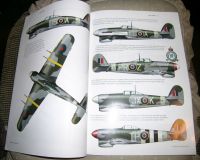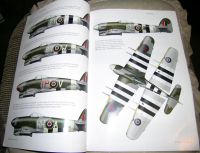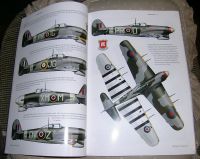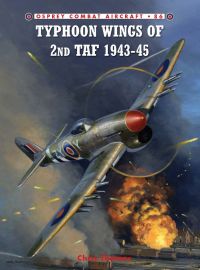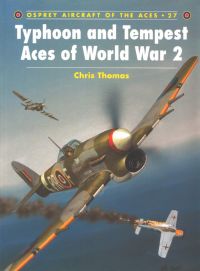Valiant Wings Publishing | Airframe & Miniature No. 2: The Hawker Typhoon (First Edition)
Reviewed by Kevin Williams
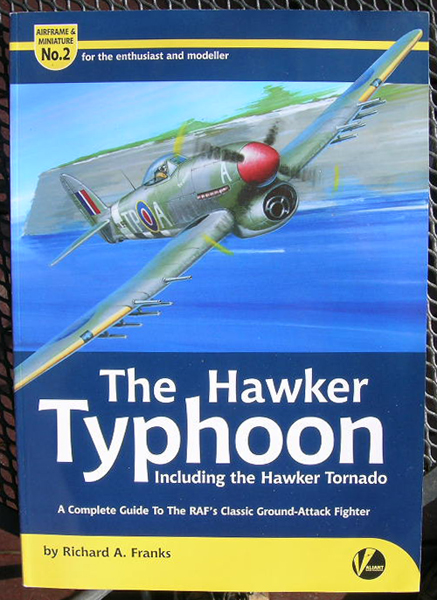
This book in the Airframe & Miniature series from Valiant Wings Publishing is the first edition of the No. 2 book in the series, The Hawker Typhoon: A Complete Guide to the RAF's Classic Ground-Attack Fighter. Written by Richard Franks, it illustrates the story of the Hawker Typhoon, and its Tornado predecessor, with slightly over 128 pages of information.
The book is divided into two main sections, Airframe Chapters and Miniature Chapters, each of which has a number of sub-sections.
Airframe Chapters
- Evolution - Tornado, 6 pages
- Evolution - Typhoon, 5 pages
- Typhoon Production, 9 pages
- Drawing-Board Projects, 5 pages
- Camouflage & Markings, 8 pages, with much, if not all of the artwork, being supplied by Richard J. Caruana
- Survivor, 3 pages
- Color Profiles, 8 pages
Miniature Chapters
- Hawker Typhoon Kits, 12 pages
- Building a Selection, 18 pages
- Building a Collection, 11 pages
- In Detail: The Hawker Typhoon, 25 pages
There is also a list of Appendices:
- Tornado & Typhoon Kit List, 2 pages
- Tornado & Typhoon Accessory List, 4 pages
- Typhoon Decal List, 3 pages
- Tornado & Typhoon Production, 2 pages
- Bibliography, 2 pages
The last part of the book features an insert of a set of fold-out plans in 1/48 scale.
The Airframe Section
The Airframe section starts off with a four-chapter summary of each variant produced, from the initial Tornado prototypes through the final production Typhoons, and the initial Tempest prototypes. This is a somewhat useful reference on the lineage of development, and is offered as typical family relationship fare, for those interested in that sort of thing. Each variant is illustrated with a port-side profile, neatly rendered in black, white, and gray.
Chapter 5 kicks off a discussion of Typhoon camouflage and markings, including breakdowns of the different styles of national insignia and squadron codes used; very beneficial when trying to determine what's correct, or probably correct, for a certain time frame.
Chapter 6 details the interesting history of the last complete surviving Typhoon, built during 1944 and at the time of the writing of this volume, was housed at RAF, Hendon, but has since been moved to the Canada Aviation and Space Museum in Ottawa. A brief list of other Typhoon sections and replicas is also included.
Page 42 kicks off an eight-page section of color profiles. These are by Richard J. Caruana, and are gorgeous, taking full advantage of the quality glossy paper used throughout. Of particular interest, are the two plan/inverse plan views illustrating the distinct differences between standard Typhoon ID stripes and D-Day invasion stripes, which are markedly different from one another, as well as the plan view illustrating the 12" wide ID stripe frequently seen on earlier Typhoons.
The Miniature Section
This section is introduced with chapter 7, a detailed look at applicable Typhoon kits. All the major scales are covered, from 1/72 to 1/24, though the Crown (now Revell) 1/144 kit is not mentioned (though it, along with other oddities, is mentioned in Appendix I). In 1/32 scale, the MDC and Revell kits are looked at in some detail.
Chapter 8, "Building a Selection", features four kit builds in 1/72, 1/48 and 1/32, the Airfix 1/24 not yet having been released at the time of this publication:
- Academy 1/72 Typhoon Mk Ib - Libor Jekl
- Czechmaster Resin 1/72 Typhoon Prototype/Mk Ia - Libor Jekl
- Hasegawa 1/48 Typhoon Mk Ib - Steve A. Evans
- MDC 1/32 Typhoon Mk Ib - Steve A. Evans
Each build article varies in the amount of detail it provides about the build itself. Personally, I see the inclusion of such material to be a complete waste of space, but given that the very nature of the publication is in part "& Miniature", certainly understand its inclusion, and will certainly not let it deter me from buying similar volumes from this same publisher, given the otherwise high quality of the effort.
Photo below is typical of what's seen in the built ups section. Nothing spectacular here, just four built models in varying scales.
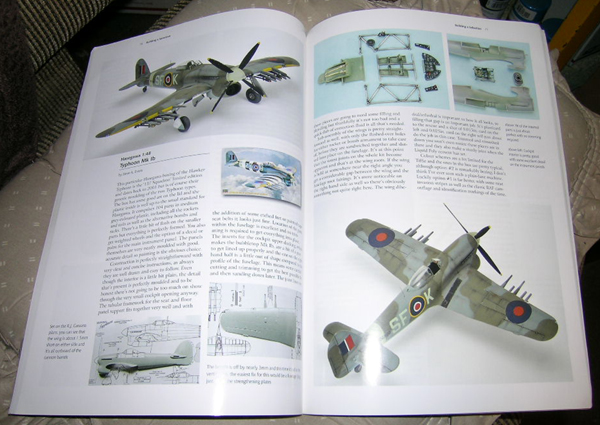
Building a Collection
Through a series of isometric 3-D drawings by Jacek Jackiewicz, this section illustrates the pertinent features of each revision of the airframe as it progressed through its development. When combined with the information presented in the first part of the Airframe section, it becomes a simple matter to understand the features present on any particular variant or sub-variant. In fact, this section could easily have been included in the Airframe portion of the book, rather than the Miniature section.
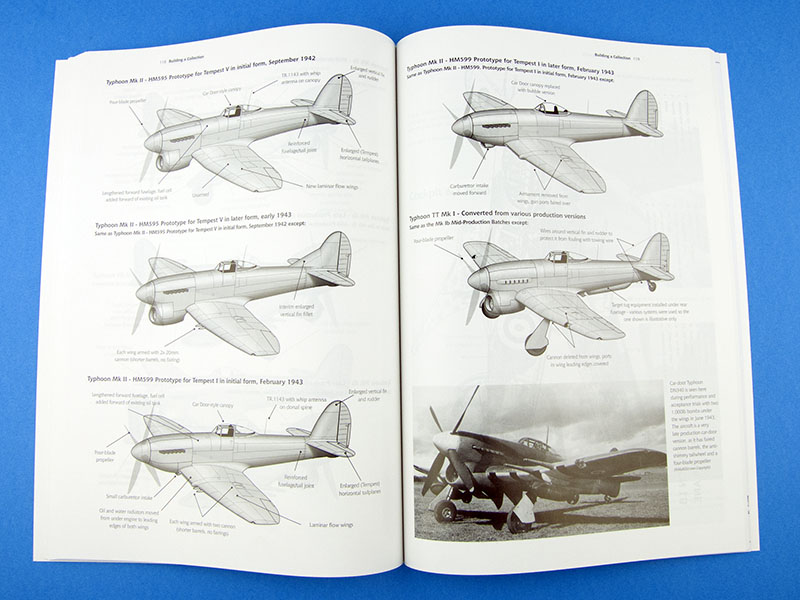
Chapter 10, "In Detail", features a series of close-up photographs and technical drawings to reveal those airframe details so often sought after by modellers. Many of the photographs are of restored airframes, so the usual caveats regarding those apply here, but they're useful nonetheless.
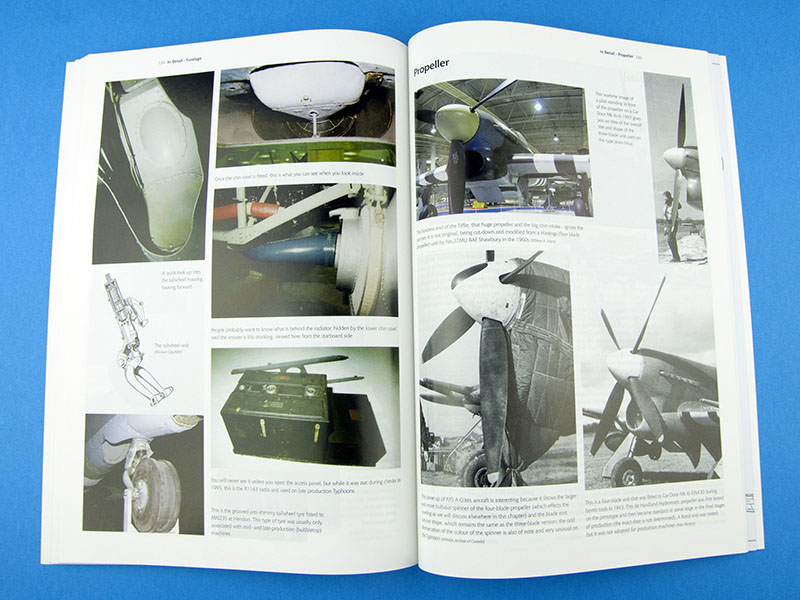
Scale Plans
The final component of the book is a set of fold-out scale plans in 1/48 scale. These are printed on a heavy plain stock, and have been drawn by Jacek Jackiewicz. The airframes featured are, predictably enough:
- Typhoon Ib Bubble-top
- Typhoon Ib Car Door
Both sets of plans include fuselage cross-sections. The plans themselves are very nicely drawn, with complete panel line and rivetting detail. My only complaint is that their fold-out nature makes them awkward to work with, and there's no convenient way of removing them from the book for separate study. Perhaps making them either easily detachable (perforated attachments?) or a separate insert might solve this problem, but it might also drive up costs and complicate production. In any case, they're still a most welcome and worthwhile inclusion.
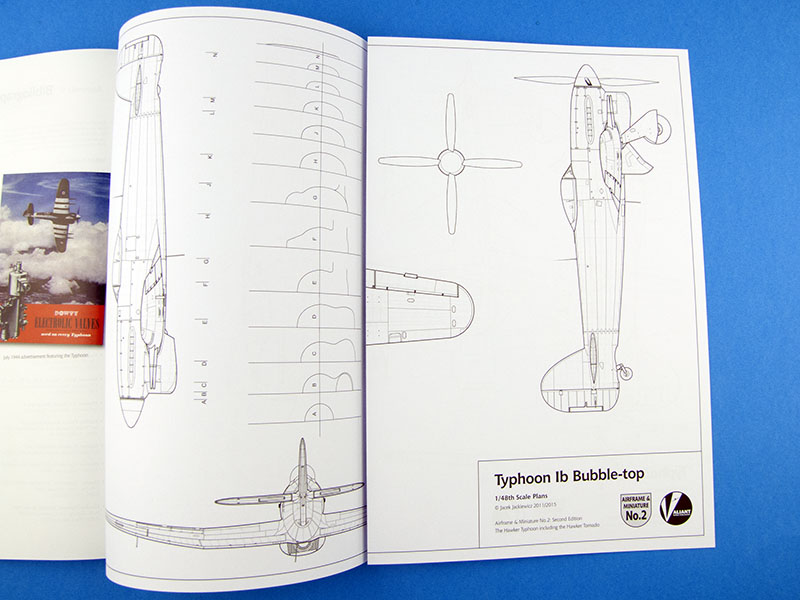
Conclusion
All things considered, this is a volume (that a couple of personal nitpicks aside), is a valuable addition to my reference collection on the iconic Hawker Typhoon, and is heartily recommended. The production values are certainly first class.
Many thanks to my wallet for the review sample.
As a comparison, please see the review on the second edition of this book, by Kevin Futter.
Other Recommended Reading/reference zmaterial
Osprey: Typhoon Wings of 2nd TAF
Osprey: Typhoon and Tempest Aces
© Kevin Williams 2015
This review was published on Thursday, November 26 2015; Last modified on Sunday, May 01 2022

